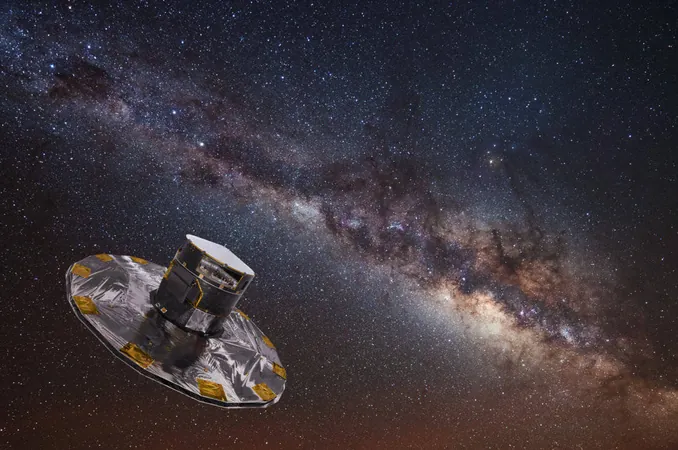
European Gaia Satellite Retires, Leaving Behind a Legacy of Astronomical Discoveries
2025-03-31
Author: Ken Lee
Introduction
The ESA's Gaia satellite, which has spent over a decade meticulously scanning our galaxy, has officially been retired. The last commands have been issued, and Gaia is now on a trajectory to secure its new retirement orbit around the Sun.
Mission Overview
Launched on December 19, 2013, Gaia was engineered with resilience in mind, incorporating multiple backup computer systems to safeguard against various threats, including radiation storms and micrometeorite collisions. Persisting through numerous challenges, including a micrometeorite strike last year, shutting down Gaia was no simple task. "Ending a spacecraft’s mission may sound straightforward," stated Tiago Nogueira, the satellite's operator, "but in reality, spacecraft resist being switched off."
Decommissioning Process
The decommissioning process necessitated a carefully crafted strategy to dismantle layers of redundancy that kept Gaia operational for so long. The objective was clear: prevent any chance of reactivation should its solar panels inadvertently catch sunlight in the future. As a poignant touch, the mission team has begun the process of overwriting sections of Gaia’s hard drive with the names of over 1,500 dedicated individuals who contributed to the project. This not only seals Gaia's fate by corrupting crucial software but also immortalizes the team's hard work.
Engineers and Emotions
Spacecraft Operations Engineer Julia Fortuno, who played a pivotal role in the shutdown, expressed her mixed emotions. "I'm torn between excitement for the essential end-of-mission tasks and sadness at saying goodbye to a spacecraft I've poured my heart into for over five years. It's been a privilege to be part of such an extraordinary mission."
Scientific Achievements
Throughout its operational lifetime, Gaia set out to create a comprehensive three-dimensional map of the Milky Way, recording the positions and movements of billions of celestial objects, including stars, planets, and comets. By capturing images repeatedly over a five-year span, Gaia collected an astonishing 200 terabytes of data for Earth-based analysis, transmitted at a rate of 3 Mbit/s.
Observations and Discoveries
The satellite analyzed more than two billion stars, conducting a staggering three trillion observations. Among its remarkable findings was the discovery that our galaxy is experiencing a slight wobble, likely due to past interactions with another galaxy. With a possible collision with the Andromeda galaxy projected in approximately 4.5 billion years, this wobble could complicate our celestial future. Gaia also identified our Solar System's position within the galactic disc and revealed our steady approach to the Milky Way's core at a velocity of roughly 0.23 nanometers/s². Moreover, Gaia unearthed the information about the closest black hole to Earth, named Gaia BH1, which is located about 1,600 light-years away.
Legacy and Future Missions
“Gaia’s wealth of data offers an invaluable resource for astrophysical research, impacting virtually all fields within astronomy,” remarked Gaia project scientist Johannes Sahlmann. The satellite's groundbreaking findings have influenced future astronomical missions and laid the groundwork for Gaia's successor, GaiaNIR (Gaia Near Infra-Red), which aims to extend this mapping endeavor using different wavelengths.
Final Days and Safety Measures
As a final act, ESA ground control has thoroughly tested Gaia’s systems, including propulsion gear, during its final days of operation. Recently, the engines were activated one last time to place the satellite in a secure parking orbit about 6.2 million miles (10 million kilometers) from Earth, ensuring it poses no risk of collision with our planet for at least a century.
Shutdown Confirmation
The shutdown process continued as the team disabled components and corrupted software to prevent any potential reactivation. With the communication systems and central computer now powered down, Gaia has officially ceased operations. However, the treasure trove of data stored on its hard drives remains—potentially serving as a time capsule for future generations.
Conclusion
Reflecting on the mission's impact, Gaia mission manager Uwe Lammers captured the sentiment of the entire team: “We will never forget Gaia, and Gaia will never forget us.” As humanity bids farewell to this pioneering explorer, the legacy of Gaia will undoubtedly resonate in the cosmos for eons to come.




 Brasil (PT)
Brasil (PT)
 Canada (EN)
Canada (EN)
 Chile (ES)
Chile (ES)
 Česko (CS)
Česko (CS)
 대한민국 (KO)
대한민국 (KO)
 España (ES)
España (ES)
 France (FR)
France (FR)
 Hong Kong (EN)
Hong Kong (EN)
 Italia (IT)
Italia (IT)
 日本 (JA)
日本 (JA)
 Magyarország (HU)
Magyarország (HU)
 Norge (NO)
Norge (NO)
 Polska (PL)
Polska (PL)
 Schweiz (DE)
Schweiz (DE)
 Singapore (EN)
Singapore (EN)
 Sverige (SV)
Sverige (SV)
 Suomi (FI)
Suomi (FI)
 Türkiye (TR)
Türkiye (TR)
 الإمارات العربية المتحدة (AR)
الإمارات العربية المتحدة (AR)